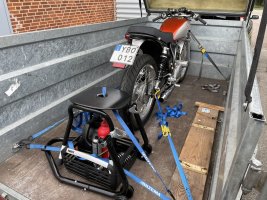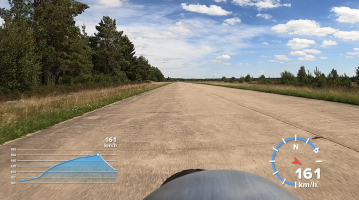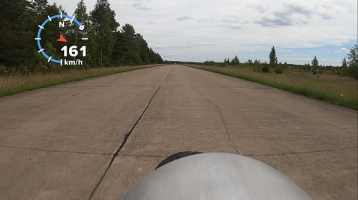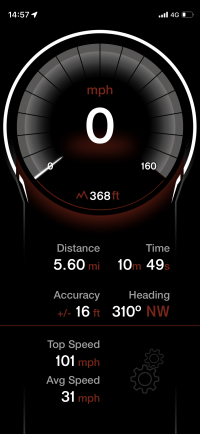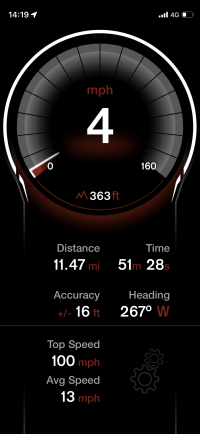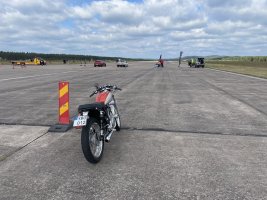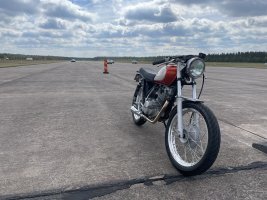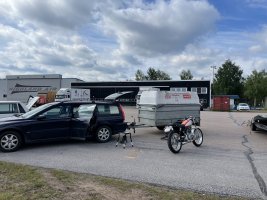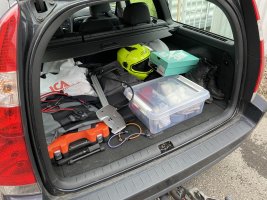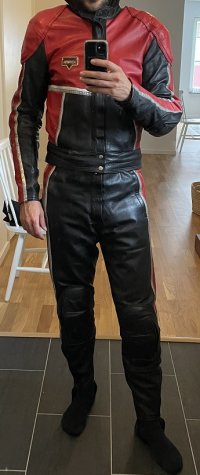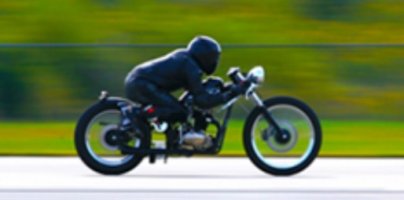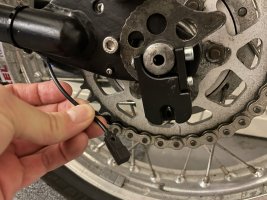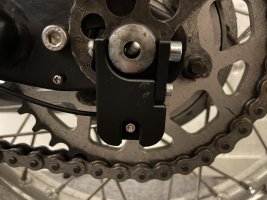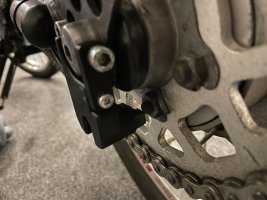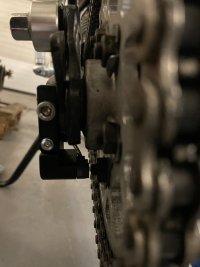I had already put the testing off once, so this time there was no backing out, I was fully committed. I booked a small enclosed trailer for the 4.5 hour road trip and packed a whole bunch of tools, spare parts, extra fluids etc and built a wooden ramp to get the bike up on the trailer. It was a pretty drama free trip and the only hassle was sticking to 80kph the whole way.
Once arriving at the event in the morning the next day, nerves turned to focused excitement. You turn up, check in, pay for special one day racing insurance, get a race number etc. Then it was time to unpack, prepare the bike, and head over to the drivers meeting. Once we were all on board for how things work, it was time to line up at the start line! I had bought a full leather racing suit of really good quality second hand online and it fit surprisingly well, so it was on with that and the rest of the safety gear.
Heading out from the paddock towards the start line there was a pretty decent headwind, which did not inspire a lot of confidence. A quick check of the weather app indicated a direct head wind of 6m/s (21kph). Later, as the wind picked up to 8m/s, some of the car guys getting up to 250+kph were saying it felt like slamming on the brakes between gear shifts just letting off the throttle. The start/timing system was really set up for cars, so it was a bit tricky to get it right with skinny spoked wheels - the laser would just pass right through them. This meant that of all 12 runs I did, only 4 got captured/timed. Anyway, my first run started alright and I got up to 142 kph. The bike felt like it had plenty more to give but just ran short of track and I had to throttle off. It also spluttered a little near max rpm on a couple of occasions right before shifting, so I thought something was off in the jetting (after a lot of thought, after the fact, I now suspect it was something else - more on that later). Even those speeds will move anything on the bike that is not 1000% secure and the gopro mounted on the handlebar did the old flipperoo and pointed skyward after getting to 120kph haha. Needed a new solution there.
I thought I would try gearing the bike down a little to see if I could get to speed faster, so I swapped the 15t front sprocket to a 14t - moving from a calculated 8500rpm at 161kph to 9100. At the same time I changed the jet needle to a richer one thinking it was going lean near the top. The next few runs resulted in similar terminal speeds and the bike was just struggling with the wind and the short distance. I still had some sputtering/hesitation high up in the rpms, so I tried swapping main jets and needle clip position a couple of times and gained no better results. One run I forgot to turn the fuel back on so half way up the track the float bowl ran dry and the bike started spluttering. I switched the fuel on mid run and hopefully no engine damage occurred due to running lean. Duh! I even swapped to shorter rear shocks to lower my profile - to no avail/no better results. I should have tried lowering the front as well, but in the heat of the moment I was focused on getting the engine to run right. I was sure that without the wind and about 1k of track at wide open throttle, the rpms and speed would have kept climbing and I would have gotten to the ton. At this point I was a little disheartened. So much build up for such an anticlimax. I couldn’t stop thinking about how I could probably get to 161kph if only heading in the other direction…
Then one run I raced another bike, a CBR1000RR (a Repsol spec bike). He of course wheelied past me and got up to like 230kph over the 804 meter distance. Then, when following him on the way back, along the taxi strip, he blasted off… so I decided to go after him! Once the revs started climbing I realised this was my chance. Luckily the gopro with gps was on (and in a new, better fixed position) and I gave it the beans for a good 1km, eventually getting to 161kph! The revs were still climbing and I probably could have gone just a tad further and a tad faster, especially if I swapped back to the 15t front sprocket. But I wanted to be respectful of the rules there and gave plenty of room, like 600m to slow down. The rules were that you were not allowed to race each other on the way back from your run but you could ‘come up to speed to cool your engines’ - so that was a bit open for interpretation and obviously the guy on the Honda thought he needed some more air through his radiator to cool his engine

But the whole area was a closed track so I deemed it safe to wring it out there.
I was pretty stoked but wanted to do it again to be sure. I finally got a run where I ran on my own (no one in the right lane) and got up to 161kph again, a repeat, not just a fluke! I managed to capture the speed with both the gopro and a gps app on my phone. Both showed a terminal speed of 100mph the first time and 101mph the second time. It felt pretty good, but almost bittersweet and I am not 100% satisfied… Full disclosure, the speed was not recorded by a third party and is therefore not official, plus the speed was obtained with a pretty decent tail wind. So that is the bitter part. However, I have now ridden this bike 100mph, twice and that feels like the goal has somewhat been achieved, that is the sweet part. I am certain that, as mentioned earlier, on a completely still day, on the flat, with a 1km straight, this bike would do the ton again and again. I wonder how factories used to do their top speed tests. On those big velodrome circuits? If this bike was able to run on one of those I am certain it would top the ton easily.
Anyway back to the mystery spluttering issue. I wondered if it was fuel starvation from the narrow opening in the quick connect connector I had installed. I decided to remove that and run a straight tube instead. This seemed to help but hard to know decisively. Then the day after, with all the time to think about it on the trip back, I came up with a theory. When dyno testing, we got perfect jetting and didn't have any of this spluttering, but we always throttled off right after reaching peak rpm. Whereas doing these tests involves sustained high rpm running. So I thought maybe I was draining the float bowl and starving the main jet and the fuel line was not able to fill the bowl quickly enough. Would that be possible? Sounds plausible. To overcome this I would either need to vent the tank better so fuel could flow at the petcock easier. Or install a vacuum operated fuel pump off of the vacuum pick up on the intake boot.
All in all, it was a sweet trip to do and would have been even more fun to do with a buddy on a similar machine - some kind of older motorcycle. If I were to do it again, I would try to enjoy the event a bit more and take time to watch the other cars and bikes and talk to more people. I was so focused on wrenching and trying to improve the bike I feel I missed out on some other cool stuff.
Whats next for this project?! Fix a few details that aren’t working great - speed sensor position/bracket and rpm pick up for example, get some decent photos of it, then ride it and enjoy it! A few more posts/updates to come yet!


